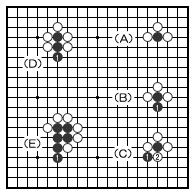Welcome to the Nihon Ki-in
HOW TO PLAY GO [ 1/3 ]
Intersection
The players place stones alternately,with the first move made by the player with black stones. A stone once placed cannot be moved. Diagram I shows the grid pattern on the surface of the'Go'board. It consists of 19 vertical and horizontal lines. Stones may be placed only at the intersections of these vertical and horizontal lines.
Dia.1
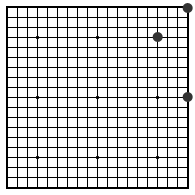

Territory
Territory is called'ji'in Japanese. Diagram 2 shows some examples. The continuous lines formed by the black stones form the limits of the territories. The size of territory is expressed in terms of the number of open intersections within it. The unit is called a point,'moku'in Japanese. The territories marked A, B and C are all of the same size..12 points for the black player. Incidentally, it is obvious here that to form territory, it is most efficient to make use of the edge lines as in the case of Pattern A. Pattern B, which makes use of one edge line is not as economical as A, but more economical than C, which must be entirely bounded by lines of stones.
Dia.2
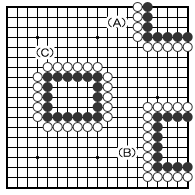

Contiguity of Stones
The unit for the number of stones is also called 'moku' the same as in the case of territory. All stones are of equal power, but like soldiers in a battle, the stones in a good configuration are more powerful than those in a poor pattern, in which the stones cannot function as effectively and economically.Stones of the same color form a firm line when they are placed contiguously along a straight line as in (A) in Diagram 3. These three black stones cannot be cut off. When they are diagonally contiguous as in (B), however, they are not directly connected with one another. Therefore, they can be cut off if the opponent places his stones as in (C). Remember an isolated stone means less power for the contestant who has such a stone.
Dia.3
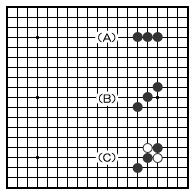

Life of a Stone
A stone has life and it may be killed. This is crucial element that makes'Go'an interesting game.In Diagram 4, Pattern A shows a black stone being surrounded by three white stones. When the fourth white stone is placed at (1), the black stone is killed and is immediately removed from the board by the white player. Pattern B shows the result of the removal of the black stone. Pattern C, D and E all show black stones that are dead because they are surrounded by the stones of the adversary.
Dia.4
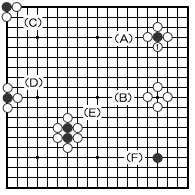

In Patterns A of Diagram 5, the black stone would be killed if the white player places the fourth stone at (a). This situation is called'atari. 'The player whose stone is in an'atari'can'run.' This may be done by placing another black stone next to the one on the board as in Pattern B. But if the second black stone is placed diagonally as in Pattern C, it is meaningless, because the white player, by placing the fourth white stone at (2) can still kill the first black stone. The black stone to be placed at (1) in Patterns D and E shows the black player's attempt at running away from capture. Pattern F in Dia.4 shows a stone with four liberties (breathing spaces).
Dia.5
